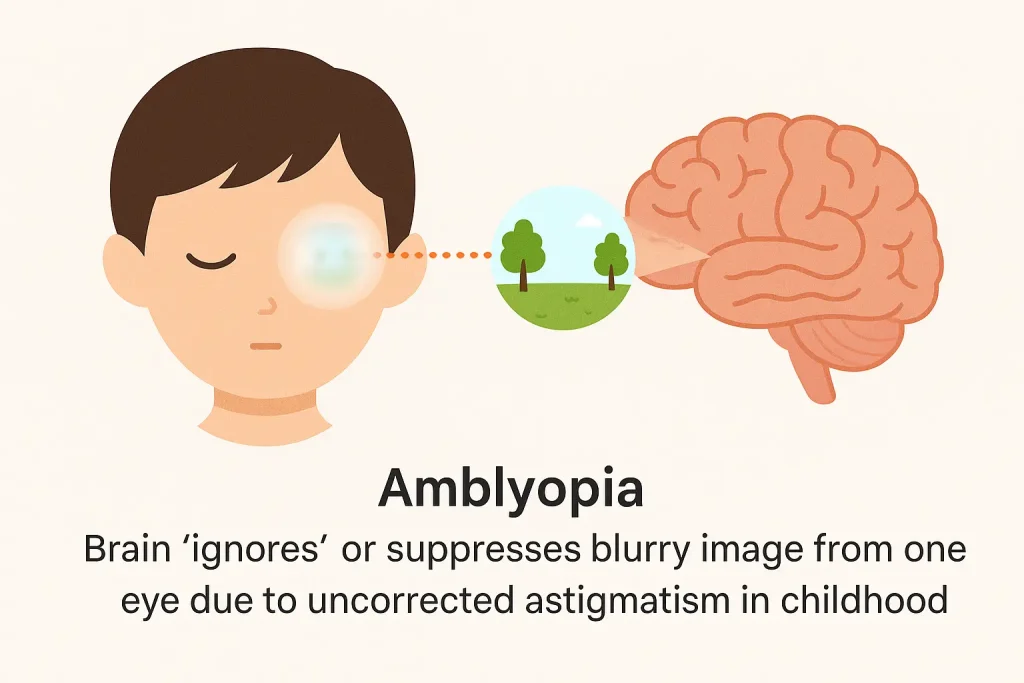Astigmatism is one of the most common refractive errors affecting people of all ages. Characterized by an irregular curvature of the cornea or lens, it leads to distorted or blurred vision.
For many, the term “astigmatism” can sound alarming, prompting concerns about long-term consequences. One of the most frequently asked questions is: Can astigmatism cause blindness? This article will explore the medical facts, recent studies, and expert opinions to clarify this concern.
Can Astigmatism Lead to Blindness?
The short and reassuring answer is no—astigmatism alone does not lead to blindness. It is a refractive error, meaning it affects how the eye focuses light but does not damage the eye’s structure. With proper diagnosis and corrective measures like glasses, contact lenses, or surgery, most people with astigmatism can achieve clear vision.
However, there are indirect risks that may lead to visual impairment if astigmatism is left uncorrected:
- Amblyopia (Lazy Eye): In children, untreated astigmatism can lead to amblyopia. If one eye has significantly more astigmatism than the other, the brain may start to ignore input from the weaker eye, causing permanent vision loss in that eye if not corrected early.
- Irregular Astigmatism Due to Eye Conditions: Conditions like keratoconus, where the cornea becomes progressively thinner and cone-shaped, can cause severe and irregular astigmatism. Without treatment, this condition can impair vision significantly.
- Eye Fatigue and Strain: Chronic eye strain from uncorrected astigmatism can affect daily functioning, increasing the risk of accidents, especially when driving or performing tasks that require clear vision.

Complications of Uncorrected Astigmatism
While astigmatism does not directly cause blindness, leaving it uncorrected, especially in significant cases, can lead to serious vision problems.
A major concern, particularly in children, is amblyopia (lazy eye), which occurs when the brain suppresses blurry input from an uncorrected astigmatic eye, potentially leading to permanent vision impairment if not treated early. Amblyopia affects 2% to 4% of children globally, and studies show a strong link, with over 90% of amblyopic children having astigmatism and ≥1.00D of astigmatism doubling the risk of visual impairment.
Beyond amblyopia, severe uncorrected astigmatism causes significant visual distortion and functional impairment in daily life, making tasks like reading and driving difficult. It also reduces quality of life, increasing the risk of falls, and leads to common symptoms such as chronic eye strain and headaches.

Astigmatism in the Philippines: A Growing Concern
According to the Philippine Eye Research Institute, refractive errors are among the leading causes of visual impairment in the country. A 2021 report indicated that more than 2.6 million Filipinos suffer from uncorrected refractive errors, with astigmatism being a significant contributor.
Additionally, a post-pandemic study revealed a rise in astigmatism cases among Filipino children aged 6–12, likely due to increased screen time and reduced outdoor activity.
Diagnosis and Monitoring
Astigmatism can be easily diagnosed during a Comprehensive Eye Screening. The most common tests include:
- Visual Acuity Test: Measures how clearly you see letters on a chart
- Keratometry: Measures the curvature of the cornea
- Refraction Test: Identifies the exact prescription needed for correction
Early detection is key, especially in children. Pediatric eye screenings are recommended before entering school and at regular intervals thereafter.

Treatment Options for Astigmatism
Thankfully, astigmatism is highly manageable with modern corrective options:
- Eyeglasses: The simplest and most common treatment
- Contact Lenses: Toric lenses are specially designed for astigmatism
- Orthokeratology (Ortho-K): Worn overnight to temporarily reshape the cornea
- LASIK and Other Refractive Surgeries: Safe and effective long-term solutions offered by specialized eye centers
Each treatment has its pros and cons depending on the severity of the astigmatism, patient lifestyle, and age. Consulting a licensed ophthalmologist is essential for determining the best course of action.
Living with Astigmatism: Management and Outlook
Living with astigmatism is manageable for most people. Consistent use of prescribed corrective lenses, whether eyeglasses or contact lenses, is key to maintaining clear vision and preventing symptoms like eye strain and headaches.
The prognosis for individuals with astigmatism is generally excellent. With proper diagnosis and appropriate management, the vast majority can achieve good to excellent vision, allowing them to lead full, active lives without significant visual limitations.
General eye health practices are also important: protecting your eyes from injury, managing any underlying health conditions, and avoiding excessive eye rubbing can contribute to overall eye well-being.
Conclusion
Astigmatism, while common and often misunderstood, does not cause blindness when diagnosed and managed properly. However, ignoring the condition—especially in young children—can lead to complications such as amblyopia or progression of other ocular issues.
In the Philippines, where digital exposure and environmental factors continue to affect visual health, regular eye examinations have become more important than ever.
At Shinagawa Lasik & Aesthetics, we are committed to providing comprehensive eye care services—from vision assessments to advanced LASIK procedures. Our mission is to help every Filipino see clearly and live fully. If you suspect astigmatism or are experiencing visual discomfort, consult with our specialists for a personalized treatment plan backed by world-class technology and expertise.
Your vision is our focus.
For inquiries, questions, and appointments, call our Patient Care Lines:
🖥 Talk to our Consultants via Livechat: https://direct.lc.chat/6329011/
📱 Instagram: https://instagram.com/shinagawa_ph/
Citations and Resources
Shinagawa LASIK & Aesthetics strives to provide accurate and reliable information regarding LASIK procedures and eye health. We utilize primary sources to support our content, including peer-reviewed scientific studies, data from reputable medical organizations, and expert opinions. We also reference established publications and research where appropriate.
Our commitment to evidence-based information ensures that you receive trustworthy and up-to-date details to make informed decisions about your eye care.
Resources Used in This Article
- PubMed. “Prevalence of Amblyopia and Refractive Errors Among Primary School Children, https://pmc.ncbi.nlm.nih.gov/articles/PMC4795390/“
- VerywellHealth. “Astigmatism and Vision Correction: What to Know, https://www.verywellhealth.com/astigmatism-8631312“
- Oscar Wylee. “Vision Impairment and Blindness: Meaning, Causes, Types, and Challenges, https://www.oscarwylee.com.au/glasses/eye/visual-impairment“
- Ophthalmology Advisor. “Glasses Do Not Reduce Amblyopia Risk for Children With Astigmatism, https://www.ophthalmologyadvisor.com/news/amblyopia-rates-similar-between-spectacle-treated-and-observed-youths/“
- AAO. “Amblyopia and Refractive Errors in Young Children, https://www.aao.org/eyenet/article/amblyopia-and-refractive-errors-in-young-children“


